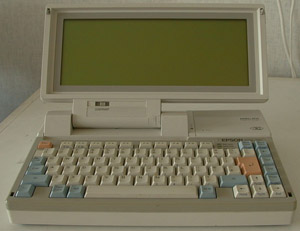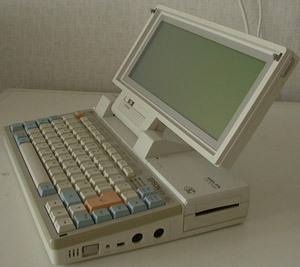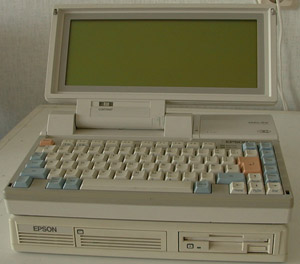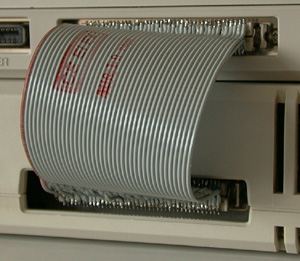The Epson PX-16
When Epson introduced the PX-16, they already had a long history in
portable computing. The HX-20, PX-4, PX-8 (Geneva) are pre IBM-compatible
machines (PX-4 and PX-8 are CP/M machines). The PX-16 is IBM PC-XT
compatible but different
from most comparable machines. The basic machine has no floppy or
hard disk, but MS-DOS 3.2 in ROM and a RAM disk for file storage.
My machine also has a PCMCIA like interface for RAM or EEPROM cards.
The normal Epson extension for this slot is a printer.
The PX-16 has a battery pack for operation, an internal battery
for memory retention and a 5V input for charging.
The disks are in a separate box, which can be attached to the PX-16
bottom. A special 80 pin cable connects both parts. The disk unit has
its own set of batteries which are charged via the 80 pin cable.
| Front |

| Information on the PX-16 is scarse on the Internet.
Epson has nothing (apart from
an accidental occurance in some list).
The PX-16 seems to be targeted at the field service engineer. I deduce
that from the multiple options to customize
it for specific tasks.
One such an application I heard from a PX-16 user was controlling a Pager
System at a broadcasting company and an airport, both in the U.K. The
cartridge port was used for the propriatary interface and software in the
ROM sockets. This system was still operational in 2004.
As was the case with the PX-4, the PX-16 was probably not or very limited
marketed in the U.S.A.
|
| Semi-side |

| The PCMCIA card bay is not an Epson product. It is from
CSM, a
german company, which are still in PCMCIA business, but do not
support this product, the MEL-PX anymore. I mailed CSM and I got a
nice reply on which cards are used by the MEL-PX. These are:
Mitsubishi 60-Pin MEL-Cards (SRAM). As modern PCMCIA cards
are 68 pins, this is a fairly non standard article.
Info in the current MEL-Card family:
www.melcard.de.
A Texas Instruments MC1128K160-20 does not work :-(. The card is detected,
but formatting fails.
Normal (68 pins) PCMCIA cards are not even detected.
From a nice visitor I learned the Texas Instruments card contains
OTP-EPROM memory (TMS27PC512FR), no SRAM. No wonder writing doesn't work.
The PROMS are connected directly to the bus, so the card has linear
memory organisation,
very probably this is also true for the MEL-card...
|
| With disk unit |

| The floppy is a 720KByte DD drive, the harddisk a 20Mbyte type.
single and dual floppy configurations were also an option.
Some more images:
The Hard disk interface board contains some analog like circuitry and an OMTI
chipset, so I assume it is an ST-506 derivate.
Info on the 26-pin HD interface.
|
| The D.I.Y. cable |

| This cable was missing. I made one by molesting several connectors
bought from Digi-key and soldering them together. There were only 160
soldering points...
|
Both the base unit batteries as the disk unit batteries were unusable
due to shorts in the cells. By "zapping" the shorts, the battery can
get usable again. This extended life span is very limited, but
ok for demo purposes (the alternative is throwing the battery away and
buy a new one). See the links below for more info on NiCd batteries.
Local links:
Generic links:
Latest update: 2018-01-01
e-mail



